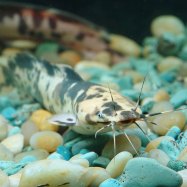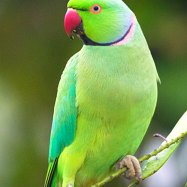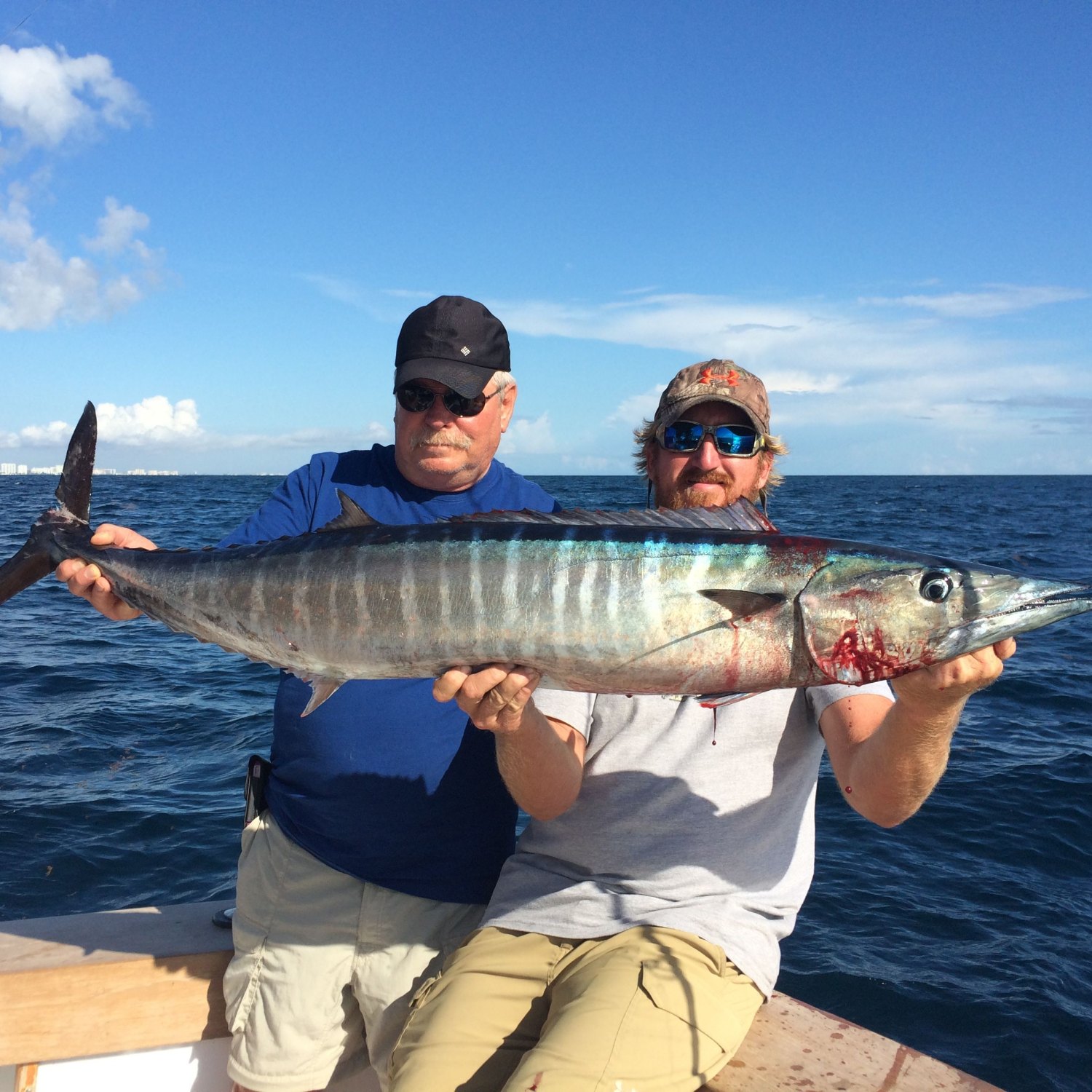
Wahoo Fish
Up to 8 feet
The Wahoo fish, found in oceanic waters, is a popular catch for recreational fishers. With a streamlined and slender body, these fish can grow up to 8 feet in length. As part of the Scombridae family, they are closely related to tuna and mackerel. Keep an eye out for this impressive swimmer on your next ocean adventure! #Wahoo #oceanlife #fishingfun #scombridae
Animal Details Summary:
Common Name: Wahoo Fish
Kingdom: Animalia
Habitat: Open Ocean
The Fascinating Wahoo Fish: A Master Hunter of the Open Ocean
The open ocean is a vast and mysterious world, home to many unique and fascinating creatures. One such creature is the Wahoo fish, also known as the Acanthocybium solandri. With its streamlined body, impressive speed, and carnivorous nature, this fish is a true apex predator of the open waters. This article will take a closer look at the Wahoo fish and its outstanding features, from its scientific classification to its impressive hunting abilities Wahoo Fish.The Basics: Scientific Name, Common Name, and Classification
Let's start with the basics. The scientific name of the Wahoo fish is Acanthocybium solandri. This name has an interesting origin, with "Acantho" meaning "spiny" and "Cybium" meaning "a kind of tuna." The species name, "solandri," honors the French explorer, Daniel Solander. However, the Wahoo fish is commonly known by its simple and easy to remember, common name - Wahoo fish.In the classification system, the Wahoo fish belongs to the kingdom Animalia, which comprises all animals. From there, it further falls under the phylum Chordata, which includes all vertebrates, such as fish, birds, and mammals. The Wahoo fish is part of the class Actinopterygii, which includes most ray-finned fish. Its order is Perciformes, which consists of over 10,000 species, including the Wahoo fish Water Buffalo. Furthermore, its family is Scombridae, the family of mackerels, tunas, and bonitos.
Exploring the Habitat and Geographical Distribution of the Wahoo Fish
The Wahoo fish is truly a global citizen, found worldwide in the Atlantic, Indian, and Pacific Oceans. Its geographical distribution is mostly in tropical and subtropical waters, where it can thrive and hunt with ease. This fish prefers the warm waters of the open ocean, away from coastlines, which is why it is rarely seen near shorelines.The Wahoo fish's preferred habitat is open ocean waters, also known as pelagic waters, because of its streamlined body and hunting strategies. Here, it can swim freely and reach impressive speeds to chase its prey. However, the Wahoo fish can also be found in nearshore habitats, such as lagoons and reefs, where it can hunt for smaller fish and invertebrates.
The Carnivorous Nature and Feeding Methods of the Wahoo Fish
The Wahoo fish is a fierce predator, known for its speed and powerful jaws. Its diet mainly consists of other fish, such as tuna, mackerel, and squid. It is an opportunistic feeder and can also hunt for smaller prey, such as squids, crustaceans, and smaller fish, which it finds in the water column.The Wahoo fish is a master hunter, thanks to its unique feeding method called "plunge-diving." It spots its prey from the surface, then rapidly descends through the water column to attack its prey. This technique allows it to reach speeds of up to 60 miles per hour, making it one of the fastest fish in the ocean. This incredible speed, combined with the Wahoo fish's sharp teeth and powerful jaws, makes it a formidable opponent for any creature in the open waters.
The Wahoo Fish's Physical Characteristics
The Wahoo fish has a striking appearance, with a metallic blue color on its back and a silver shade on its sides. It also has 24-31 dark, vertical bands running along its body, which gives it a unique and eye-catching look.Aside from its coloration, the Wahoo fish also has a distinct body shape that helps it thrive in its habitat. Its body is streamlined and - thanks to its fusiform shape - can reach great speeds efficiently, allowing it to chase and catch its prey. Its large, powerful tail provides propulsion as it maneuvers through the water, making it an excellent swimmer.
The Wahoo fish can grow up to 8 feet in length, making it an impressive sight for any diver or fisherman lucky enough to encounter one in the open ocean. However, the average size for a Wahoo fish is around 5-6 feet, and it typically weighs between 40-100 pounds.
The Country of Origin and Threats to the Wahoo Fish
The Wahoo fish is an oceanic species, so it can be found in open waters worldwide. However, it is considered a game fish in countries like Mexico, South Africa, and the United States, where it is frequently targeted by recreational anglers. It is also a commercial fish, with its meat being sold in markets and restaurants worldwide.Unfortunately, the Wahoo fish population is facing challenges due to overfishing. Its fast growth rate and reproductive potential have helped sustain the population so far. Still, increased fishing pressure has led to a decline in numbers, particularly in the Caribbean region. The International Union for Conservation of Nature (IUCN) currently categorizes the Wahoo fish as "near threatened" on the Red List, and it is essential to continue monitoring and conserving this magnificent species.
In Conclusion: A Marvel of the Open Ocean
The Wahoo fish is truly a remarkable creature, with impressive physical characteristics and hunting abilities that make it a top predator in the open ocean. Its speed, power, and cunning nature make it a marvel to observe, and it is an excellent example of how fascinating and diverse our ocean's inhabitants can be. However, it is also essential to remember the threats facing this species and work towards conservation efforts to ensure that it remains a vital part of our marine ecosystems for years to come.

Wahoo Fish
Animal Details Wahoo Fish - Scientific Name: Acanthocybium solandri
- Category: Animals W
- Scientific Name: Acanthocybium solandri
- Common Name: Wahoo Fish
- Kingdom: Animalia
- Phylum: Chordata
- Class: Actinopterygii
- Order: Perciformes
- Family: Scombridae
- Habitat: Open Ocean
- Feeding Method: Carnivorous
- Geographical Distribution: Tropical and Subtropical Waters
- Country of Origin: Found worldwide in the Atlantic, Indian, and Pacific Oceans
- Location: Oceanic waters
- Animal Coloration: Metallic blue on the back and silver on the sides
- Body Shape: Streamlined and slender
- Length: Up to 8 feet
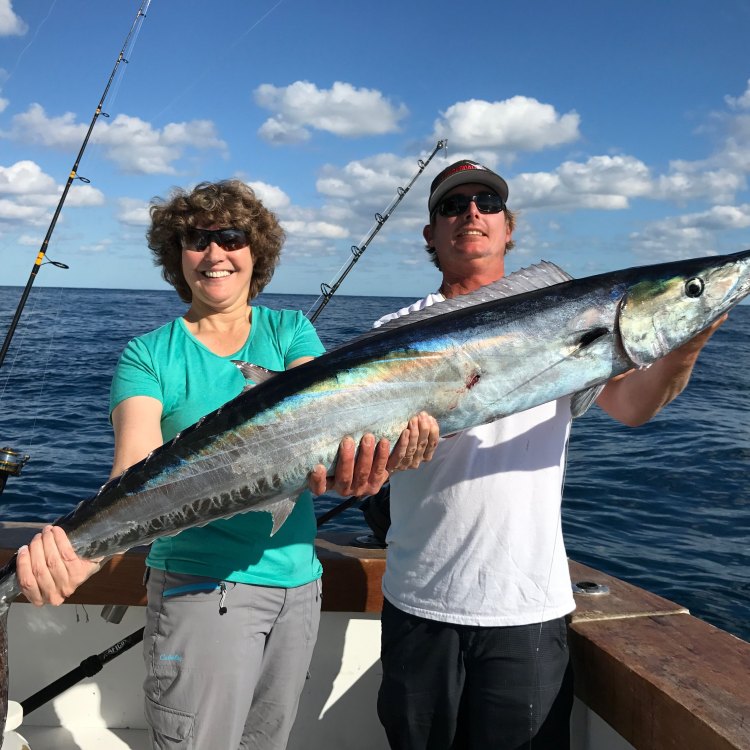
Wahoo Fish
- Adult Size: Typically 4 to 5 feet
- Average Lifespan: Around 4-5 years
- Reproduction: Sexual
- Reproductive Behavior: Spawning
- Sound or Call: No specific sounds or calls
- Migration Pattern: Seasonal migrations in search of food
- Social Groups: Solitary or small groups
- Behavior: Fast and agile swimmers
- Threats: Overfishing, habitat destruction, climate change
- Conservation Status: Not listed as threatened
- Impact on Ecosystem: Important predator in its ecosystem
- Human Use: Commercial and recreational fishing
- Distinctive Features: Long, pointed jaws with razor-sharp teeth
- Interesting Facts: Wahoo can swim at speeds of up to 60 miles per hour
- Predator: Sharks and large predatory fish
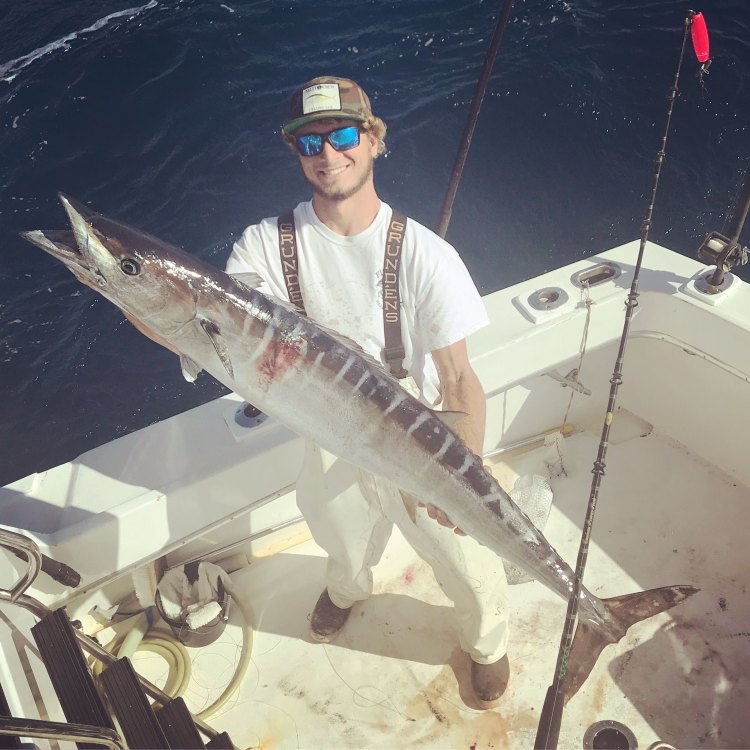
Acanthocybium solandri
The Fascinating World of the Wahoo Fish and its Impact on the Ecosystem
The ocean is full of mysterious and unique creatures, one of which is the Wahoo fish. This elusive and fascinating species is known for its impressive speed, razor-sharp teeth, and important role in its ecosystem. In this article, we will dive into the world of the Wahoo fish, exploring its distinctive features, behavior, and impact on the environment.The Wahoo fish, also known as Acanthocybium solandri, is a large and predatory fish found in tropical and subtropical waters around the world PeaceOfAnimals.Com. They are typically found in the Atlantic, Pacific, and Indian Oceans, with a preference for warm waters. This fast and agile swimmer can reach sizes of up to 4 to 5 feet in length and has an average lifespan of 4-5 years. Let's take a closer look at this intriguing species.
The Reproduction and Sexual Behavior of Wahoo Fish
Wahoo fish are known to be sexual and reproduce through a method called spawning. Spawning is a process where the female lays her unfertilized eggs in the water, and the male fertilizes them externally. This behavior usually occurs during the breeding season, which varies depending on the location. In some regions, Wahoo fish spawn all year round, while in others, it occurs during specific months.Seasonal Migrations in Search of Food
Wahoo fish are known for their seasonal migrations in search of food. During colder months, they tend to move towards more temperate waters, while in warmer months, they return to their tropical habitats White Rhinoceros. These migrations allow them to follow their prey, which consists of smaller fish like mackerel, squid, and herring. This behavior also helps regulate their body temperature and prevent them from freezing in colder waters.Quick and Agile Swimmers with Razor-Sharp Teeth
One of the most distinctive features of the Wahoo fish is its long and pointed jaws with razor-sharp teeth. This is where their nickname, the "hoo," comes from, as it resembles the word "jaws." These teeth are perfectly evolved for hunting and feeding on their prey, allowing them to tear through flesh with ease. Their streamlined body and powerful tail make them impressively fast and agile swimmers, with the ability to swim at speeds of up to 60 miles per hour.The Importance of Wahoo Fish in the Ecosystem
Wahoo fish play an important role in their ecosystem as top predators. They help regulate the population of their prey, preventing overconsumption of resources and ensuring a healthy balance in the food chain. Without the Wahoo fish, there could be an overabundance of smaller fish, which could lead to a decrease in other vital species. This highlights the crucial role this species plays in maintaining a healthy and diverse marine ecosystem.Threats to the Wahoo Fish and Conservation Efforts
Despite their importance in the ecosystem, Wahoo fish face threats from human activities. Overfishing is one of the biggest threats to their population, as they are highly valued for their meat and considered a delicacy in many countries. As a result, they are a popular target for commercial and recreational fishing, leading to a decline in their numbers.Habitat destruction and climate change are also contributing factors to the decline of Wahoo fish populations. As the oceans become warmer and more acidic, it can affect the survival and reproductive rates of this species. Additionally, pollution and the use of harmful fishing practices can also have a negative impact on their population.
Thankfully, the Wahoo fish is not currently listed as a threatened species. However, it is essential to continue monitoring their populations and implementing conservation efforts to ensure their survival. This includes regulations on fishing limits, sustainable fishing practices, and protection of their habitats.
The Human Use of Wahoo Fish
Aside from being a popular catch for commercial and recreational fishing, Wahoo fish also have economic importance for local communities. They are a valuable source of income, providing jobs for fishermen and contributing to the local economy. Wahoo fish is also highly sought after in the culinary world, prized for its firm and flavorful meat.Interesting Facts About Wahoo Fish
Here are some fascinating facts about Wahoo fish that you may not have known:- Wahoo fish are highly migratory and can cover thousands of miles in just a few weeks.
- They are often mistaken for their close relatives, the king mackerel, as they have similar body shapes and patterns.
- Unlike other fish, Wahoo do not have a swim bladder, which helps them maintain their position in the water. Instead, they rely on their powerful swim muscles.
- Wahoo fish do not make any specific sounds or calls. They communicate using their body language and movements, especially during spawning.
Predators of Wahoo Fish
While Wahoo fish may be top predators in their ecosystem, they do have their own predators. Large sharks and other large predatory fish, such as marlin and tuna, are known to feed on Wahoo fish. These predators play an important role in maintaining a balance in their population and preventing overconsumption.The Thrilling World of Wahoo Fish
The mysterious and impressive Wahoo fish is undoubtedly a species worth learning about. From their unique features and behavior to their vital role in the ecosystem, they are a truly fascinating species. However, it is crucial to recognize and address the threats they face to ensure their survival for future generations to appreciate and enjoy. As with all marine life, it is essential to remember the importance of responsible and sustainable practices to maintain a healthy and diverse ocean ecosystem. So, the next time you're out on the water, keep an eye out for the elusive Wahoo fish, and remember the important role it plays in the ocean.
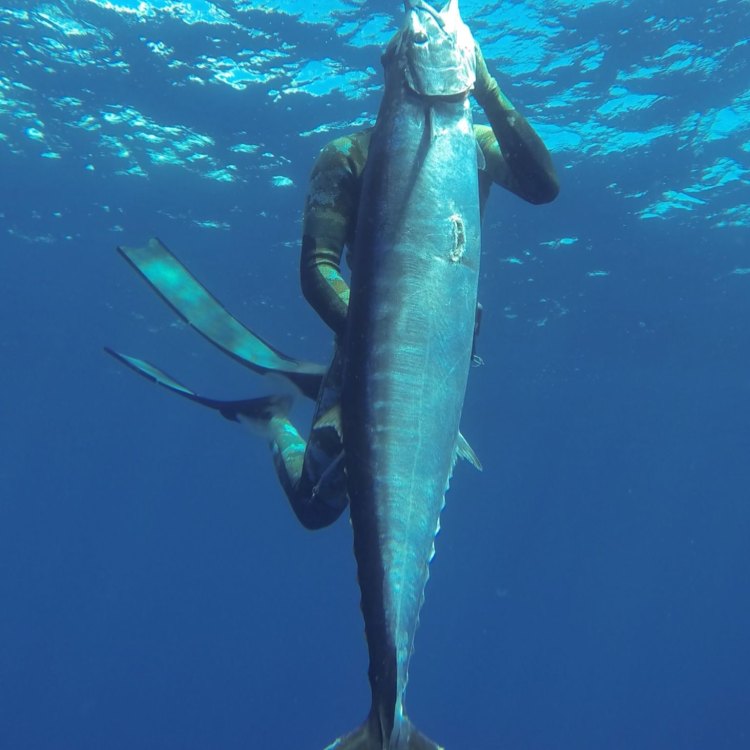
The Fascinating Wahoo Fish: A Master Hunter of the Open Ocean
Disclaimer: The content provided is for informational purposes only. We cannot guarantee the accuracy of the information on this page 100%. All information provided here may change without prior notice.



